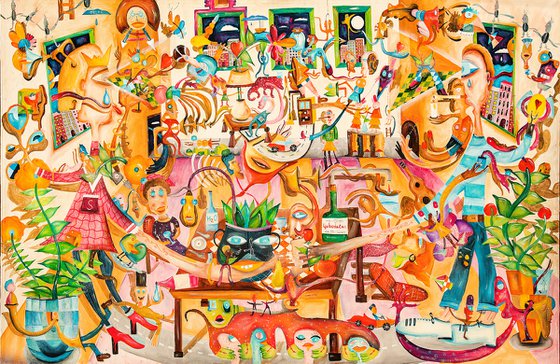Main Navigation
Original artwork description:
Folie à deux ('madness [shared] by two'), also known as shared psychosis[2] or shared delusional disorder (SDD), is a psychiatric syndrome in which symptoms of a delusional belief, and sometimes hallucinations,[3][4] are transmitted from one individual to another.[5] The same syndrome shared by more than two people may be called folie à... trois ('three') or quatre ('four'); and further, folie en famille ('family madness') or even folie à plusieurs ('madness of several').
The disorder was first conceptualized in 19th-century French psychiatry by Charles Lasègue and Jules Falret and is also known as Lasègue–Falret syndrome.[3][6]
Recent psychiatric classifications refer to the syndrome as shared psychotic disorder (DSM-4 – 297.3) and induced delusional disorder (ICD-10 – F24), although the research literature largely uses the original name.
This disorder is not in the current DSM (DSM-5), which considers the criteria to be insufficient or inadequate. DSM-5 does not consider Shared Psychotic Disorder (Folie à Deux) as a separate entity, but rather, the physician should classify it as “Delusional Disorder” or in the “Other Specified Schizophrenia Spectrum and Other Psychotic Disorder”.
Materials used:
Oil on canvas
Tags:
#painting #contemporary #fairytale #abctract #folie àFolie A Deux (2021) Mixed-media painting
by Rikardo Druškić-Jekić
1 Artist Reviews
£1,614.87 Sold
- Mixed-media painting on Canvas
- One of a kind artwork
- Size: 160 x 105 x 1cm (unframed)
- Signed on the back
- Style: Graphic, illustrative and typographic
- Subject: Animals and birds
Do you like this artwork?
This artwork has sold, but the artist is accepting commission requests. Commissioning an artwork is easy and you get a perfectly personalised piece.
Loading
Original artwork description
Folie à deux ('madness [shared] by two'), also known as shared psychosis[2] or shared delusional disorder (SDD), is a psychiatric syndrome in which symptoms of a delusional belief, and sometimes hallucinations,[3][4] are transmitted from one individual to another.[5] The same syndrome shared by more than two people may be called folie à... trois ('three') or quatre ('four'); and further, folie en famille ('family madness') or even folie à plusieurs ('madness of several').
The disorder was first conceptualized in 19th-century French psychiatry by Charles Lasègue and Jules Falret and is also known as Lasègue–Falret syndrome.[3][6]
Recent psychiatric classifications refer to the syndrome as shared psychotic disorder (DSM-4 – 297.3) and induced delusional disorder (ICD-10 – F24), although the research literature largely uses the original name.
This disorder is not in the current DSM (DSM-5), which considers the criteria to be insufficient or inadequate. DSM-5 does not consider Shared Psychotic Disorder (Folie à Deux) as a separate entity, but rather, the physician should classify it as “Delusional Disorder” or in the “Other Specified Schizophrenia Spectrum and Other Psychotic Disorder”.
Materials used:
Oil on canvas
Tags:
#painting #contemporary #fairytale #abctract #folie à14 day money back guaranteeLearn more

